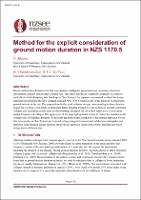| dc.contributor.author | Bhanu, Vishvendra | |
| dc.contributor.author | Chandramohan, Reagan | |
| dc.contributor.author | Sullivan, Timothy | |
| dc.date.accessioned | 2023-08-28T04:23:23Z | |
| dc.date.available | 2023-08-28T04:23:23Z | |
| dc.date.issued | 2023-04-19 | |
| dc.identifier.uri | https://repo.nzsee.org.nz/xmlui/handle/nzsee/2565 | |
| dc.description.abstract | Recent studies have demonstrated that longer earthquake ground motion duration can reduce structural deformation capacity and increase collapse risk. This study introduces a method to explicitly account for such effects while designing new buildings in New Zealand. An equation is presented to adjust the design drift limit prescribed in the New Zealand standard NZS 1170.5, based on the target duration of anticipated ground motions at the site. The proposed method is used to derive designs corresponding to three duration targets for a 4-storey case-study steel moment frame building located on a site in Nelson. Hazard-consistent collapse risk assessment results indicate that buildings designed for lower drift limits have a lower mean annual frequency of collapse. The application of the proposed method is found to reduce the variation in the collapse risk of buildings designed for different duration targets, compared to the existing approach. Given that several sites in New Zealand are exposed to large-magnitude crustal and subduction earthquakes and therefore, long duration ground motions, the proposed approach can provide a better uniform-risk based design across different sites. | |
| dc.language.iso | en | |
| dc.publisher | New Zealand Society for Earthquake Engineering | |
| dc.relation.ispartofseries | 2023;71 | |
| dc.subject | Advancements in structural and geotechnical assessment and design | |
| dc.title | Method for the explicit consideration of ground motion duration in NZS 1170.5 | |
| dc.type | Article | |

